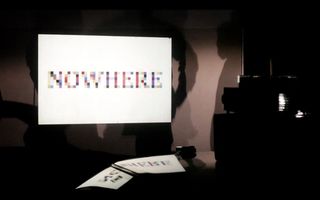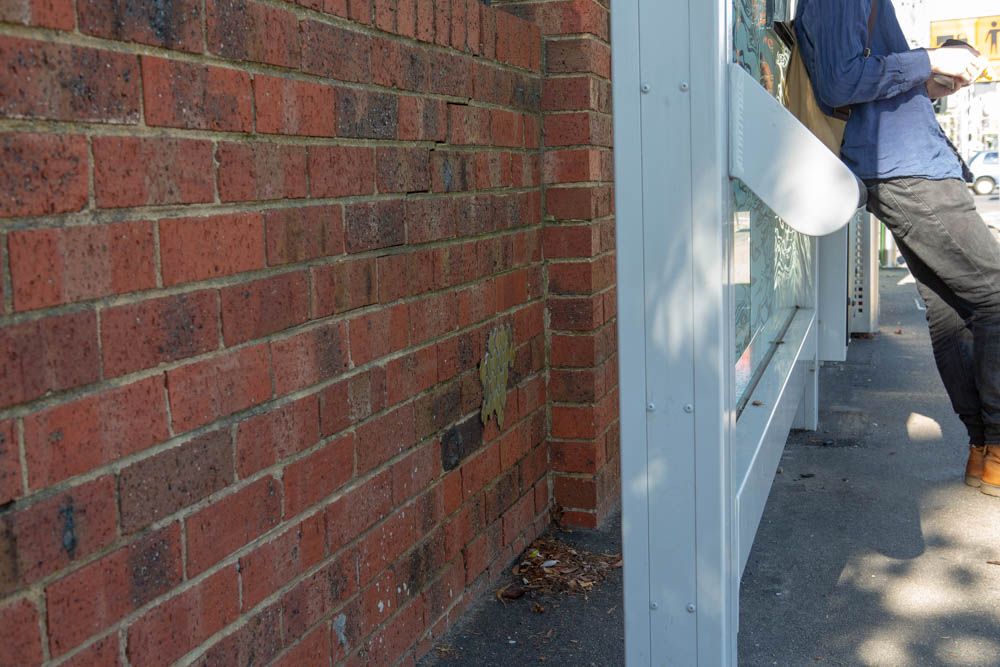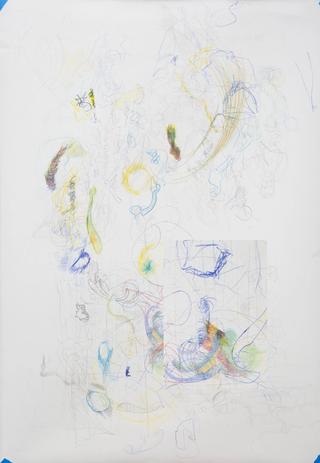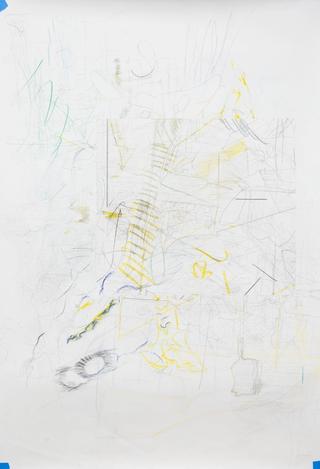

VIRTUAL SIGNALLING
Lucy Foster, Cameron Hurst, NWEB, Zoë Bastin
1 Jun–31 Jul 2021
“Every period has its own optical focus.” - László Moholy-Nagy
Last year, with what felt like the flick of a switch, our lives became enmeshed within the fabric of the virtual in an upheaval that was as sudden as it was comprehensive. The digitalisation of contemporary life that accompanied social isolation gave rise to a new visual regime occupying the cultural psyche: that of the invisible. Catalysed by the threat of an invisible virus, the vast majority of us have become subordinate to digital technologies that serve as gateways to the virtual matrix, an intangible ‘space’ host to its own language, logic and governance, mapped across a complex circuitry of hidden networks. It is in this invisible field connecting invisible sites that we enact our working and social lives via the ceaseless transaction of invisible data, participate in invisible markets with invisible currency in exchange for invisible commodities, and attend invisible events, meetings and classrooms, all as voices occupying invisible bodies, as consumers surveilled, measured and shaped by invisible algorithms. As internet culture becomes simply culture at large, today, the horizons marking the limits of the knowable world trespass beyond that which is perceivable towards that which is conceivable. Amidst the recent frenzy of online exhibition outcomes, curatorial algorithms, and the growing rage and regulation of digital art economies, how might this shift in visuality impact art, a practice once so invariably tethered to the visible, to the material, to the perceptual?
Commissioned for the launch of MOBILE, BLINDSIDE’s new digital projects platform, Virtual Signalling is an online exhibition project inviting four Victorian artists to interpret the task of image-making for the digital space. Bringing together the perspectives of practitioners whose work spans a diversity of attitudes and forms, Virtual Signalling ponders the conditions, challenges and possibilities of cultural production in the virtual arena at a moment when the margins separating IRL and URL have never been more indistinct.
Zoë Bastin
That Which Was Once Familiar (again and again), 2021
If, as Boris Groys put it, digital images are “copies with no visible original,” therefore to be seen “they must be staged,” then it could be said the online exhibition shares a common goal with performance art: to envision the invisible. In That Which Was Once Familiar (again and again), choreographer and dancer Zoë Bastin does just that. Fashioned from documentary footage of the artist’s recent major dramatic work, That Which Was Once Familiar, the video work sees Bastin perform improvised movement in which body and music wrestle on stage in a martial exchange charged with tension and release. As the dust settles, the violent interplay of sound and movement culminates as dancers race to enclose and escort our fallen fighter, empowering her with the strength and spirit to endure. Testimony to the transformative virtue of communal action, hereby enabling the body to double as both weight and support, That Which Was Once Familiar (again and again) offers not just a stirring statement of feminine solidarity and courage. Moreover, Bastin’s message serves as a hopeful reminder of the social and emotional power of the body, whether physical or collective, at a critical moment when embodied experiences have been deprived.
Zoë Bastin, That Which Was Once Familiar (again and again), 2021, video, 1:54min. Editor credit: Louis Roach. Image credit: Bri Hammond. Courtesy the artist.
Cameron Hurst
Everything You Need to Know About the NFT Boom
Listen, bro, I know NFTs. I’ve watched Brad Troemel. I’ve read Dean Kissick. I’ve listened to Dean Kissick. I’ve lurked on the New Models Discord. I refuse on principle to traffic in Jerry Saltz, but you can if you want. I’ve roleplayed “Woman in STEM” on GitHub, looking at a project offering mutual band-aids for some of the rocketing sea levels climate change effects of PoW.
Trust me, I’m an expert. Crypto girlbosses in Iran–seen them. JPEG-lords in Dubai–heard of them. I’ve watched my friend receive a bid for a video of A1 Bakery for $600, then, spiralling, accidentally send it to the crypto void. I’ve trawled through all the NFT marketplaces: Zora for techno-utopia; Folia for multidisciplinary Berlin-based; NiftyGateway for hype drops; KodaDot to see why nobody gives a single shit about eco-NFTs, the metal straw of digital art. I’ve felt absolute and complete spiritual ennui, pure existential dread, and wondered if my soul was minted by a Discord bot without my knowledge. Then I’ve recharged with a triple feature of CashedCobraZHouseWriter, Anohni, and Matt Dryhurst, and jumped back into the ring. In this essay, I’ll tell you everything you need to know about getting started in the crazy world of NFTs.
TLDR: we’ve got bigger things to worry about.
I reject the idea that it’s nearly impossible to understand NFTs. Everypublicationunderour pollution-dimmedsunhaswrittenanexplainer. Anyone who makes a cursory effort to understand them, understands them. Dignified people just don’t care. One argument is that they instinctively recognise how craven NFTs are (as Brad Troemel says, a pyramid scheme within a pyramid scheme), and wisely sidestep the discourse. But it’s beside the point whether NFTs (and cryptocurrencies and blockchains) are technically good or bad. Forget the diseased little phrase “non-fungible token” for a moment. The crypto boom and incoming bust is merely a product of a macro NFT: the neofeudal theocracy we’re living under.
In March 2021, the filmmaker Adam Curtis went on Chapo Trap House. He observed that
[t]he early mythology says that computers can understand the complexity of the world more than you… Somehow, big data can understand the world better than we can. That we’re limited human beings. In a funny way, it’s quite a religious view. It says that there is something that knows us and the world more than we do, which, of course, is God.
I think that this idea–that technology now occupies the cultural role once held by an omnipotent, almighty God–is a powerful one. It says something about a naturalised 21st century paradigm: that complex technology is inexorably expanding outside of human understanding, and that this upwards progression is a good thing. I disagree. The world was objectively already getting worse for the majority of people in it even before a global pandemic-induced recession. The political theorist Jodi Dean writes that the term “neofeudalism” serves to “name tendencies associated with extreme inequality, generalized precarity, monopoly power, and changes at the level of the state.” Capital is dead: this is something worse. A theocracy is a political system in which the ruler has power above rational, normie comprehension through access to transcendent communion with a divine agent: a king is seen as God’s emissary on Earth.
Elon “The Dogefather” Musk is the most conspicuous king of the neofeudal theocratic hellscape. In May 2021, Musk hosted Saturday Night Live. He wore a bulky black Givenchy suit and guffawed uncontrollably as his head dipped up and down. “I believe that humanity must become a multi-planetary space-faring civilisation… now I think if I just posted that on Twitter, I’d be fine. But I also write things like ‘69 days after 420 haha.’” He smirked. I gagged. Musk is the third richest man in the entire world. NFT-hawking swordpop mogul Grimes was there, too, waving her bony wrists about in a Princess Peach costume. It’s all just a garish simulacra at this point. Pseudo-scion Musk and Grimes, his complicit accessory, function as the peak signifiers of tech mythology in the popular imagination. I would find it super funny and crazy to see this quirky e-boy and his e-girl together on live TV if they weren’t the most powerful people in a pathologically inequitable world, but then they wouldn’t be there.
We are living in crazy times, bro, seriously. Grimes made $5.8 million in 20 minutes selling fugly floating cyborg cherubs. Dogecoin is up 12, 000% since January. The guy who shorted subprime mortgages in 2008 just put down $530 million against Tesla. An estimated 6000 people are dying a day from pandemic-related hunger. Nothing seems to make any sense, as Adam Curtis would say. Vaccines are available for rich people while poor people continue to die. “Jeff Bezos could pay each of his 876,000 employees a $105,000 bonus and still be as wealthy as he was at the onset of the pandemic.” Amazon just successfully ran one of the most crushing union-busting rackets in history. This might seem like a random collection of numbers and facts, but it isn’t. All speak to two central tenets of contemporary life that we should question at all costs: the supposed omnipotence of the Big Data up in the sky, and the purported inevitability of maniacally speculative financial capitalism. We need new models. I’m not a purist. I just don’t want to settle for a false monarch’s crypto crumbs while the world burns.
They say: Let them eat nonfood.
We say: No gods, no masters, no dogefathers. Behead big tech billionaires.
I’m investing in love, friends, communal meals, family, union dues, and a cool pencil drawing I saw in an exhibition on Sydney Road the other day. Disclaimer: This is not financial advice.
Writer Cameron Hurst applies spatial metaphor from an alternate angle in her incisive essay ‘Everything You Need to Know About the NFT Boom’. Mapping her argument across a constellation of cultural citations made possible by hyperlinks, Hurst’s text shrewdly observes that counter-culture, once defined by its distance from power, is now determined by its proximity. Adapting cultural theorist Adam Curtis’s contention that digital technology has supplanted God as an omnipresent, all-knowing and invisible force, Hurst asserts that as a culture of so-called ‘digital natives’, we have become subjects of a ‘neo-feudal theocracy’ (a tongue-in-cheek subversion of NFTs, or non-fungible tokens), whereby a new monarchy headed by Jeff Bezos, Mark Zuckerberg and Elon Musk assumes the throne.
Lucy Foster
nowhere nothing, 2021
For experimental lens-based artist Lucy Foster, the digital impulse reflects a broader existential pursuit of using technology to overcome the mortality of the body through the creation, dissemination and archiving of digital traces. Commissioned for Virtual Signalling, nowhere nothing is the video record of a live event in which the artist projected digitally compressed images of ambiguous text via an analogue slide carousel. Here, Foster poetically equates the entropy of the physical body with that of the digital file, proposing that, whether composed of cells or pixels, both are subject to decay. In nowhere nothing, the concept of ‘translation’ becomes literal. Just as digitalisation transcodes image into text, a process that is itself a form of writing, Foster in turn converts text into image to create a work caught in a coil of categorical uncertainty.
Lucy Foster, nowhere nothing, 2021, video, 3:03min. Courtesy the artist.
NWEB (Nothing Works Except Beige)
The Index Doesn’t Care Playaaaaaaaaaaaaa, 2021
Ideas around entropy and permanence resurface in the work of emerging art collective NWEB (Nothing Works Except Beige), whose series of pictures document the duo’s sculptural interventions throughout suburban sites. Assembled using discarded household materials and discretely installed in unorthodox public spaces, The Index Doesn’t Care Playaaaaaaaaaaaaa’s status as an artwork is made precarious by its misrecognition as refuse. Here, strategies of camouflage, recycling, and re-placement double as metaphor mirroring the dislocation of the digital image as a virtually reproducible index. What this index stands for and how it will be recognised depends on the hardware/software environment through which it is accessed. According to media theorist Lev Manovich, it is precisely this level of variability in the image’s reception that distinguishes digital media apart from other kinds of images. This sense of the dislocation of digital imagery is no less emphasised by work’s low-resolution appearance, grid-like presentation and arbitrary file titles, a format intentionally mimicking the often frustrating experience of navigating online image search galleries.
NWEB (Nothing Works Except Beige), The Index Doesn’t Care Playaaaaaaaaaaaaa, 2021, digital images. Courtesy the artists.




























Blindside Mobile is a curated online platform for projects in the digital space by Victorian-based creatives.
Mobile is supported by the Victorian Government through Creative Victoria.
This program takes place on the land of the Wurundjeri people of the Kulin Nation. We recognise that sovereignty was never ceded - this land is stolen land. We pay respects to Wurundjeri Elders, past, present and emerging, to the Elders from other communities and to any other Aboriginal or Torres Strait Islanders who might encounter or participate in the program.
Lucy Foster is a Naarm based artist who works across a range of media including photography and installation. Her practice engages with assemblage through the use of found objects, imagery and texts. Aesthetically, these materials show signs of decay and loss to their function, information or context. This reflects Lucy’s recurrent exploration into experiences of mortality and loss.
Lucy graduated from a Bachelor of Fine Arts with Honours in 2018 at the Victorian College of the Arts. She has curated and participated in a number of solo and group exhibitions locally and internationally. Selected exhibitions include third eye, Seventh (2020); silent raptures, Stockroom (2020); matter of course, Bus Projects (2019); an end seems very finite, Cathedral Cabinet (2019); healthy loss, Castlemaine Art Space (2019); group show, Low Standards, Oslo, NO (2019); you make me sick, Second Space Projects (2018); crossed hair, Testing Grounds (2018); Majlis Award, Margaret Lawrence Gallery (2016); and more or less, The Běhal Fejér Institute, Prague, CZ (2015).
Cameron Hurst is a writer from Naarm/ Melbourne. She is a contributing editor of Memo Review, an editor of Index Journal, a co-host of the Clam & Jackie Bam show on Crawl Radio and teaches art history and cultural studies subjects at the University of Melbourne and Monash University.
NWEB is a collaborative project run by Clara Joyce and Hugo Blomley. The project is a heterotopia with an adaptive methodology interested in the potential of collaboration and networks of organisation.
Zoë Bastin (b. 1992) is an artist, curator, sometimes writer and self-described rat-bag. As an artist who makes performances, sculptures, videos, photos and runs a radio show she’s fascinated by the porousness of the body, where it starts and ends and how culture inscribes ideas of gender and sexuality onto our physical form.
Since childhood she has been fascinated by gender roles in dance class; particularly who’s allowed to do what and why. Her work challenges limitations placed on feminine and femme bodies shifting ideas about gender. Using her own style of creative dance mixed with contemporary performance art Zoë creates works that explore difficult psychological terrain. From the homophobia of her religious childhood to delving into the gender politics of ballet her works are often hard hitting. But from this deep emotional investigation comes the joy of dancing itself.
Bastin recently submitted her PhD at RMIT University, where she was researching gender by transforming patriarchal hierarchies in bodies and objects. In 2021 Zoë she is working with a team of six dancers on an immersive performance called That Which Was Once Familiar presented by Dancehouse and Bus Projects for Midsumma Festival and curating an exhibition with Claire Watson called CONFLATED for NETS Victoria. Zoë is co-director of Idyll Projects a siteless exhibition platform founded with fellow artist Jessica Curry.
Bastin has previously exhibited and performed at Bus Projects, The Substation, Wyndham City Council, SEVENTH Gallery, MADA Gallery at Monash University, Testing Grounds, School of Art Gallery RMIT University, Tinning St Presents, c3 Gallery and BLINDSIDE.
Karl Halliday is a Belfast-born curator, photographer and writer based between Narrm/Melbourne and Boorloo/Perth. Karl’s curatorial pursuits leverage his specialised interest in contemporary photography, conceptual art and performance theory with a focus on pedagogical approaches to exhibition making and art programming. Karl currently serves as Grants Coordinator and Vice Chair on BLINDSIDE’s board of directors. He holds a Master of Art Curatorship from the University of Melbourne.
Related

9–26 Jun 2021
All worlds are flat
Liam Denny, Lou Hubbard, Tara Denny, Lucy Foster, Jasper Jordan-Lang, Spencer Lai, Cezary Poniatowski, Piotr Skiba

22 Aug–8 Sep 2018
Presence
Anna Horne, Archie Barry, Isabella Hone-Saunders, Holly Bates, Lou Fourie, Zoë Bastin














